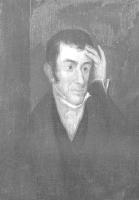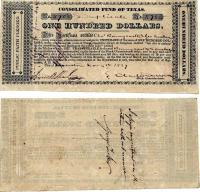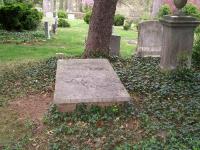Charles Bonnycastle1
#52, (1796 - 1840)
| Father | John Bonnycastle1 (1751 - 1821) |
| Mother | Bridget Newell1 (1754 - 1825) |
| Relationship | Son of John Bonnycastle |
| Charts | 5 Generations of Descendants of Charles Bonnycastle (1796-1840) Bonnycastle Ancestors of Alan H C Lankford (Deborah's line) |
Family | Ann Mason Tutt (1807 - 1873) |
| Children |
|
Life Events | |
| Occupation | Charles was one of the first professors at Thomas Jefferson's newly opened University of Virginia. He was recruited from England to teach natural philosophy [physics], then moved to mathematics instruction. He received several U.S. patents. |
| Birth | Charles Bonnycastle was born on 6 Nov 1796 in Woolwich, Kent.1 |
| Baptism | He was baptized on 6 Dec 1796 in St Mary Magdalene Woolwich, Kent. He was noted to be the child of John & Bridget.1 |
| Research Note | The birthdate inscribed on his gravestone is 22 November 1796. |
| (Heir) Will | He was named an heir in the will of his father John Bonnycastle dated 17 Aug 1816.2 |
| Note | Charles Bonnycastle Willcox, born in Portsea, Hampshire, in 1818 was an illegitimate baby and the custom of the time was for the given names to be those of the father, e.g. Charles Bonnycastle. It remains to be proved whether or not that was the case here. In his Cambridge bio, Charles' father was said to be Charles but on his marriage certificate it was said to be James. |
| Item | In 1824, Charles Bonnycastle wrote an addenda to the 13th edition of 'Introduction to Algebra', authored by his father John.3 |
| Item | On 26 Oct 1824 the ship Competitor, with Charles Bonnycastle aboard, left London but on 5 Dec 1824 she was still tied up in Plymouth due to weather and Jefferson intended to begin lectures at the University of Virginia on Feb. 1st.4 |
| Item. | In 1824 and 1825, C Bonnycastle was listed in the Royal and Imperial Calendar as one of seven foremen at the Chatham Dockyards. This was a public office.5 |
| Passenger List | He was found on the arrivals manifest of the ship Competitor from London captained by E.P. Godby which arrived in the District of Norfolk & Portsmouth in the United States on 11 Feb 1825. Passengers included Robley & Harriet Dungleson (Dr of Medicine), Chas Bonnycastle 27 Profr of Natl Philosophy, Thomas H & Sarah Key (Profr of Mathematics), Robert Lee 16, and F.W. Colquhoun 15. All intended to become inhabitants of the United States.6 |
| Item. | On 15 June 1825, Dr Emmet at the University of Virginia wrote a letter to his sister Jane. One paragraph reads: I entertain a very warm friendship for Mr Bonnycastle and shall undoubtedly bring him home with me next vacation. He is unmarried, and altho' not handsome, is so amiable, gentleman like and well informed, that he cannot fail being highly esteemed when once known.7 |
| Marriage | He married Ann Mason Tutt on 10 Jan 1826 in Locust Hill, Leesburg, Loudoun County, Virginia. Locust Hill is an early 19th-century Federal style mansion that was built by the Mason family.8,9,10 |
| Newspaper | Published 28 Jan 1826 in the Virginia Herald Prof Bonneycastle of the U of Va, to Miss Ann Mason Tutt, eldest daughter of Charles Tutt.9 |
| Item. | On 10 April 1826, Charles wrote a letter to University of Virginia proctor Arthur Spicer Brockenbrough regarding the placement of his scientific instruments.11 |
| Item. | Charles received a letter dated 21 April 1826 from Thomas Jefferson regarding the arrangement of a lecture room.11 |
| Item | All the original professors at the University of Virginia owned or hired household slaves. Their pavilions had additions made to accommodate the domestics. The proctor had the cellar under the dormitory that Bonnycastle used as a study fitted up for his slaves. Students were also served by slaves. At the Monticello dispersal sale in January 1827 following Thomas Jefferson's death, Charles Bonnycastle bought Patsy Fossett, age 17, for $395. Patsy was the daughter of Edith (Edy) the cook and Joseph (Joe) the blacksmith at Monticello. Joe was freed in Jefferson's will. By the time of the 1850 census, Patsy was living free in Cincinnati. Schulman relates: "A serious incident of student abuse of a slave occurred when students assaulted Professor Bonnycastle's slave Fielding. When accused the students replied that Fielding was very insolent to two students who were trying to disperse a large group of free "Negroes in the street." Fielding had told them not to interfere. They hit Fielding several times with a switch and later with a stick, and when he displayed "an insolent manner" as he moved away, they pursued, overtook and beat him until he "humbled himself." After urging Fielding to run, Professor Bonnycastle had been held back by one of the students who later declared "that any man who would protect a negro as much in the wrong as Fielding is no better than a negro himself." The case was left to the courts to resolve." No evidence of action taken was found in the Albemarle County Law Order book 1837-41.12,13,14 |
| 1830 Census | Charles Bonnycastle was listed as the head of a family on the 1830 census taken on 1 Jun 1830 in Albemarle County, Virginia. This was a household of 14 people. The tally showed one male under 5 years of age, one male 30-39, 2 females under 5, one female 20-29. The tally of slaves was 2 males under 10, one male 24-35, one male 36-54, two females under 10, one female 10-23, one female 24-35, and one 36-54. One person was noted to be an alien. [Roughly 2/3 of the households had slaves] |
| Note. | The tallies in the 1830 census show 5 family members and 9 slaves. These correspond to Charles (alien), his son John, wife Ann and daughter Ann. However, there are two females under the age of 5, so either they had a visitor, or a daughter that we are unaware of, or daughter Mary was born much earlier than 1837 that the newspaper notice about her death indicated. |
| Note. | On 29 June 1833, Charles Bonnycastle of Charlottesville Virginia was granted a patent for "Roofs, covering with sheet iron &c."15 |
| Note. | On 21 January 1834, Charles Bonnycastle of Charlottesville Virginia was granted a patent for "Canals, constructing, applying locomotive engines to boats, barges &c.15 |
| Note. | On 17 August 1835, Charles Bonnycastle of Leesburg Virginia was granted a patent for "Roofs, covering with tin &c."15 |
| Item. | In 2021, during renovations of Pavilion VIII at the University of Virginia evidence was found of a roof installed in the 1830s designed by its then-resident Charles Bonnycastle. You can find several online articles about this. Here is one https://news.virginia.edu/content/workers-find-remnants-1830s-era-roof-pavilion-viii-renovation. |
| (Executor) Will | He was named an executor in the will of his brother Richard Henry Bonnycastle dated 17 Jul 1837 in London.16 |
| Item. | The Republic of Texas government issued stock in “The Consolidated Fund of Texas” with 10% per annum interest due on a five year note. This example dated 4 Nov 1837 at Houston and housed at Southern Methodist University in their Texas currency collection was made out to Charles Bonnycastle and George Tucker (a fellow professor) and signed by the Comptroller of Texas, James B Shaw. Shaw would become Bonnycastle's son-in-law twenty years later.17 |
| Item | Charles Bonnycastle and his brother Humphrey Bonnycastle were mentioned in a Kalamazoo, Michigan history book as follows: "From time to time villagers found prominent people in their midst. Some like Epaphroditus Ransom and Charles Bonneycastle came to settle. Others appeared on one of the daily mail coaches and left soon afterwards. Ransom came in 1834. He settled on farm lands south of Lovell and built a fine home that survived until a few years ago. Like Justus Burdick he brought a degree of sophistication to village life until he left to become governor of the state in 1848. Charles and Harry Bonnycastle boarded at the Kalamazoo House in the early years. Then they were called back to England where Harry took a seat in the House of Lords. They left behind only the name they gave to Bonniecastle Lake west of the village."18 |
| 1840 Census | Chs Bonnycastle was listed as the head of a family on the 1840 census taken on 1 Jun 1840 in St. Ann's Parish, Albemarle County, Virginia. This was a household of 12 people - 5 family members and 7 slaves. The tally showed one male age 10-14, one male 30-39, one female 5-9, one female 10-14, one female 20-29. The tally of slaves was 2 males under 10, one male 24-34, one female under 10, one female 10-23, and two females 24-34. One person's occupation was in the category "learned professions & engineers."19 |
| Note. | The tallies in the 1840 census correspond to Charles (learned professions), his son John, wife Ann, and daughters Ann and Mary. Mary's age grouping puts her birthdate between 1831 and 1835, a couple of years earlier than her reported age at death. |
| Will | Charles Bonnycastle wrote a will. I have Charles' will and probate records. |
| Death | Charles died on 31 Oct 1840.20 |
| Burial | He was buried in University of Virginia Cemetery, Charlottesville, Virginia.20 |
| Gravestone | His gravestone reads: Sacred to the memory of Charles Bonnycastle late Professor of Mathematics in the University of Virginia who was born in London on the 22nd day of November 1796 was made professor in the University in 1825 and continued in this station until his death on the 31st of October 1840.21 |
| Item. | "Bonnycastle actually came to the University at its opening in 1825 as the first professor, not of mathematics, but of natural philosophy (as physics was then called). When Thomas Key, the first Professor of Mathematics, resigned to return to his native England, Bonnycastle shifted over to the mathematical chair and remained in that post until his untimely death on 31 October 1840 at the age of only forty-three. "Old Bonny," as he was fondly called by the students, moved away from what was increasingly becoming the antiquated synthetic approach to mathematical pedagogy that had been so typical of Oxbridge mathematical teaching in the eighteenth and early nineteenth centuries and introduced the more avant-garde analytic approach of late eighteenth-century French authors such as Silvestre Lacroix. In 1834, he published his own textbook, Inductive Geometry, in which he aimed to unite the best of the synthetic and the analytic approaches to geometry for the college- and university-level audience. Bonnycastle also contributed works on mathematical and physical topics to the Transactions of the American Philosophical Society, one of the few venues available in early nineteenth-century America for the publication of original work in the sciences."20 |
| Item. | Exerpt from the Southern Literary Messenger, January 1842: The loss of Professors Bonnycastle and Davis, gave the University just cause to mourn. They were among her chief supports, and were taken away in the meridian of their usefulness. We cannot forbear a slight tribute to their memory. Mr. Bonnycastle was one of the early professors who came over from England with Mr. Gilmer in 1824. Though young, his high qualifications fitted him alike for several of the chairs in the University. He first filled that of Natural Philosophy, and on the return of Mr. Key to England, succeeded to the mathematical, which he filled with preeminent ability up to the time of his death. he was always acknowledged to be the possessor of a great mind, which readily made him master of the most abstruse learning. The study of mathematics seemed to be to him but a process of attentive reading. As a lecturer, he was clear, patient and powerful; and, in matters of science, he was a complete agrarian, levelling its difficulties to the comprehension of every mind. At times, in one short aphorism, he would display a profundity of thought quite startling; and his students declared, that, by way of illustration,he frequently solved difficulties which had perplexed them in other branches of their studies. Mathematics was rendered by him, what he repeatedly said it was, "a pure system of logic." Many parts of his course were supplied by himself; and he wrote a text book for his class, which gained him great renown. It has been already stated, that his acquirements were not confined to his own department; nor were they even to science. He was fond of rambling through the rich and varied fields of literature, and culled their fair flowers with no little taste and judgment. His general reading was extensive, he was a graceful and an imaginative writer, as is shown by the few productions which he has left, and his conversation was unusually entertaining and instructive. In society and at home, he was often taciturn; and it was only at certain times that he opened his stores of information; but when he did, he never failed to charm and to surprise. He was a man of thought, rather than of feeling, and, though he was observant of his duty, and mindful of his obligations, he acted more from the convictions of a well-regulated mind, than from any prompting of the heart. His character has been misunderstood. He was neither selfish, nor austere. The intellectual predominated; but he was not devoid of benevolence. His habits of deep reflection made him often indifferent to what was passing around him; and, in his moods of abstraction, he would sit in the midst of his playful children, perfectly unconscious of their bewitching gambols. Their easy confidence and familiarity proved that there was no austerity in his nature. In his domestic relations he was exemplary. He married a Virginia lady; and whatever deficiency of the softer and benevolent feelings of our nature, there was in his character, was amply supplied by her amiability and overflowing kindness. I do not know that he ever became a citizen of the United States, though he frequently spoke of his intention to do so. He thought very favorably of our country and her institutions. Mr. Bonnycastle was a close student; and, perhaps, his devotion to study led to a premature death. He took very little exercise, studied in an unhealthy posture, and until a late hour of the night. The University sustained a great loss in his death; and may his successor prove it not irreparable.22 |
| Last Edited | 4 Mar 2022 |
Citations
- Baptisms of St Mary Magdalene Woolwich, Kent. Register at London Metropolitan Archives. Image viewed at Ancestry. Charles Bonnycastle, 1796.
- Will and Administration of John Bonnycastle, Professor of Mathematics in the Royal Military Academy Woolwich, 17 August 1816, proved in the Prerogative Court of Canterbury, 27 September 1821.
- Sir Leslie Stephen ed. Dictionary of National Biography, Oxford University Press, London(1921-22) (http://www.ancestry.com, digital images), Bonnycastle, John p 824.
- Philip Alexander Bruce, History of the University of Virginia, 1819-1919. 5 vols. (New York: Macmillan, 1920-22), p.10.
- Image of the Royal and Imperial Calendars viewed at Find My Past.
- Atlantic Ports Passenger Lists, 1820-1873 & 1893-1959. Images viewed at Ancestry.
- Thomas Addis Emmet, A memoir of John Patten Emmet, MD: formerly professor of chemistry and materia medica in the University of Virginia (New York: privately printed, 1898). Viewed at archive.org.
- Frederick A. Virkus, The Abridged Compendium of American Genealogy (n.p.: n.pub., 1925; reprint 1987), p.802, Robinson family genealogy.
- Index to Marriages & Obituaries, Richmond newspapers, 1736-1982, compiled by Bernard J Henley, Library of Virginia, online at http://eagle.vsla.edu/henley/, Virginia Herald, 28 January 1826.
- Photograph of the Ann Mason Bonnycastle gravestone at Cave Hill Cemetery, Louisville, Kentucky, taken by Barbara Murray, 2005.
- Letter from Thomas Jefferson (Monticello) to Charles Bonnycastle, 21 April 1826. University of Virginia Library, transcription online.
- Lucia Stanton, Slavery at Monticello (n.p.: n.pub., 1996).
- Gayle M Schulman, "Slaves at the University of Virginia" (Paper, presented to the African American Genealogy Group of Charlottesville, 2003).
- Webpage Th: Jefferson Encyclopedia (http://wiki.monticello.org/mediawiki/index.php/…), Slaves Who Gained Freedom.
- United States Patent Office, Commission of Patents Henry L Ellsworth, A digest of patents, issued by the United States, from 1790 to January 1, 1839 (Washington: Peter Force, 1840).
- Will and Administration of Sir Richard Henry Bonnycastle, Captain in the Corps of Royal Engineers, 17 July 1837, proved in the Prerogative Court of Canterbury, 17 March 1848 (Family History Library, Film #0156663).
- Southern Methodist University, Central University Libraries, DeGolyer Library. Image posted online.
- Peter Schmitt and Balthazar Korab, Kalamazoo: Nineteenth-Century Homes in a Midwestern Village (Kalamazoo: Kalamazoo City Historical Commission, 1976), page 18.
- 1840 Federal Census for United States, Virginia, Albemarle County, Roll 549, Page 134. Digital image viewed at Ancestry.com.
- University of Virginia Math History website,. <http://www.math.virginia.edu/MathHistory/bonnycastle.htm>
- Photograph of the Charles Bonnycastle gravestone at University of Virginia Cemetery, taken by Vicky Bradt (UVa), April 2008.
- Thomas W White, "Southern Literary Messenger" (published monthly, Richmond, Virginia), Vol. VIII, No. 1, page 50-1.
- Webpage Gunston Hall Plantation: Descendants of George Mason (http://www.gunstonhall.org/masonweb/intro.html).
- Death Records of Kentucky, 1852-1953, Anne Mason Robinson, 1918, #10911. Image viewed at Ancestry.
- Letters from William Robinson (Rob) Bonnycastle, Prince Albert, Saskatchewan, to J Kolthammer, dated beginning in 1990.
- Index to Marriages & Obituaries, Richmond newspapers, 1736-1982, compiled by Bernard J Henley, Library of Virginia, online at http://eagle.vsla.edu/henley/, Richmond Whig, 30 Jan 1857.





